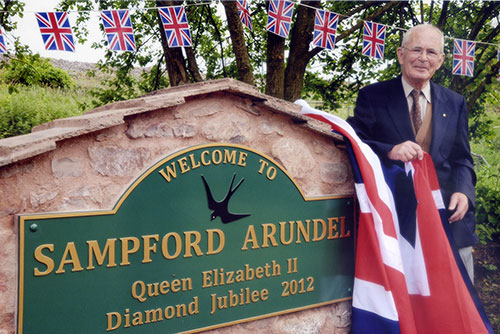
The parish of Sampford Arundel embraces the village of Sampford Arundel and the hamlets of Sampford Moor and Whiteball. It is comparitively tiny, encompassed within a 7 mile boundary, part of which borders with Devon. The population of around 320, curiously has altered little over the past 200 years.
The first element of its name comes from Saxon times and the place known as 'sandy ford' which straddled the 'King's highway' near to the area of the present Beam Bridge. The corruption to Sampford came much later in history.
The adjunct Arundel was added after the Norman conquest when the manor was given by William the conqueror to Roger de Arundel who led William's army in the battle of Hastings.
The church is dedicated to the Holy Cross and dates from the 12th. Century. It was substantially rebuilt in the mid 19th. Century and two of its six bells date from a much earlier time.
An event in 1225 shattered the normal quiet life of the village, when the Lord of the Manor, the tyrant Nicholas Arundel was pursued by angry villagers from his manor house to the church. When the priest refused him sanctuary, the villagers set upon Nicholas and killed him. Most of them were hanged but some escaped to the woods.
The railway reached the parish on the 1st May 1843 terminating at Beam Bridge until exactly one year later when it continued westwards through the completed Whiteball tunnel. This was another of Brunel's engineering feats in the construction of the Great Western Railway and involved over 1,000 navvies in the work of excavating the 1,092 yard long tunnel which opened on 1 st May 1844.
A significant association between the parish and the railway occurred on the 9th May 1904. The locomotive City Of Truro hauled the first train in the world to achieve a speed of 100 mph as it descended the gradient from Whiteball tunnel down what is known as:
'the Wellington bank'.
But the railway made little long-term impact on the village and the 19th century Sampford Arundel was a fairly typical rural community, with several farmers, a blacksmith, wheelwrights, boot makers, known as 'cordwainers', a butcher, a miller and publicans, referred to as 'beer sellers'.
There was a post office for a few years from 1861 to 1866. The village didn't get another post office until about 1902 which remained open with the addition of a small shop until the 1990's.
Today the village has a thriving primary school, a first rate cricket team, a village hall which is well used by local organisations such as the W.I. the gardening club and senior citizens, also a pleasant village green which hosts the annual summer fete.
Sampford Arundel retains the air of a parish unaffected by change and the roar of high speed trains and the constant hum of traffic on the M5 motorway which sweeps immediately behind Sampford Moor are mere reminders of a world that simply passes it by.